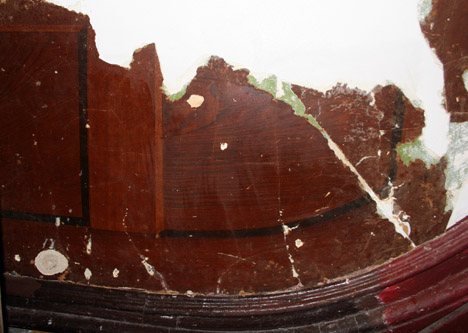We started chipping away at peeling paint and plaster behind an old radiator in the brownstone and made an interesting discovery. The “wood grain” in the above photo is not wood at all. It’s actually painted plaster and it looks as if it’s original to the house. This was the only area of the hallway not skimcoated during our restoration because the radiator was still connected.
The question now is: How far do we go? Now that we found it, we don’t want to cover it up again.
Do we keep that one area uncovered?
Keep going up the stairs?
Leave the faux as we found it?
Restore the entire thing?
I know what I’d like to do. But I also know our limitations on time and budget. And let’s not forget…this is the hallway. Our apartment is not even livable yet.
What would you do?


6 Comments
Awesome find! I say wait until you are finished with your apartment then go for it!
It is hard to say how you should approach your lucky find of the painted plaster behind the radiator. If you have a wainscotting with a cap going up the stairs then the painted plaster will probably go all the way up too.
This would be a wonderful addition to your apartment. It also could be an utter disapointment if parts of it have been damaged or removed over the years.
You might want to remove some of the new skimcoat at several spots along the stairs to see if the wood graining is still there.
This is a perfect example to remind everyone to look throughly to the idea of restoring before you begin a project, especially if you are working on an older building.
Many times less is more.
Oooooo….tough call. It seems like it could be a very laborious project you’re thinking of tackling. I agree with Bert to check the condition at several different points along the way up the stairs. And…I also agree with Julie. Can you back burner it while you work on the apartment? I say your living space has to be the priority for sure.
Yeah, I think it’s going to stay this way for awhile. We’re good at that…starting a project and not finishing it. Although, the radiator will probably have to go back into place at some point.
I actually have a question about this. How can you take off the plaster or paint and not destroy what’s underneath? I have no idea how to accomplish stuff like this.
I think because this was a faux job, it has poly or shellac on top of the original paint. That always makes it easier when taking top layers off because the paint doesn’t adhere to the poly too well.
The hubby just started scraping chipped lead paint (without a mask!!) in this instance and made the discovery. If it’s something that can’t be stripped, like plaster, you have to scrape. You can tap it to crack it and take off lots of coats that way, but be careful not to damage what’s underneath.
And always wear a mask!